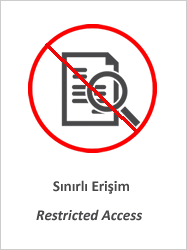Selenium and Clarithromycin Loaded PLA-GO Composite Wound Dressings by Electrospinning Method

View/
Access
info:eu-repo/semantics/embargoedAccessDate
2021Author
Çiftçi, FatihAyan, Sümeyra
Duygulu, Nilüfer
Yılmazer, Yasemin
Karavelioğlu, Zeynep
Vehapi, Meryem
Çakır Koç, Rabia
Şengör, Mustafa
Yılmazer, Hakan
Özçimen, Didem
Gündüz, Oğuzhan
Üstündağ, Cem Bülent
Metadata
Show full item recordCitation
ÇİFTÇİ, Fatih, Sümeyra AYAN, Nilüfer DUYGULU, Yasemin YILMAZER, Zeynep KARAVELİOĞLU, Meryem VEHAPİ, Rabia ÇAKIR KOÇ, Mustafa ŞENGÖR, Hakan YILMAZER, Didem ÖZÇİMEN, Oğuzhan GÜNDÜZ & Cem Bülent ÜSTÜNDAĞ. "Selenium and Clarithromycin Loaded PLA-GO Composite Wound Dressings by Electrospinning Method". International Journal of Polymeric Materials and Polymeric Biomaterials, 70.11 (2021): 2-11.Abstract
Diabetic wounds are very problematic wounds that have a high risk of infection. The healing process
of wounds in diabetic patients is more complicated than others. Wound dressing preparation
is one of the promising treatment modalities for repairing damaged tissues in diabetic patients.
The aim of this study is to demonstrate the antibacterial effects of drug release of clarithromycin
from poly(lactic acid) (PLA) nanofibers incorporated with selenium (Se) and graphene-oxide (GO)
to reveal their wound healing potential. In the present study, optimized PLA was combined with
graphene oxide (GO) with a concentration of 0.45 wt%, 1wt%, 1.50 wt%, 2wt%, 2.50 wt%, and
3wt%, respectively, and the combination was produced by modified Hummers method. After that,
optimized PLA/GO was incorporated with Se and clarithromycin with PLA with the percentage by
weight of 1:1, nanofiber patches were successfully produced by the electrospinning technique. In
vitro antibiotic test, cell culture tests (cytotoxicity test, cell adhesion, and in vitro wound healing
assay), morphological analysis (SEM), molecular interactions between the components (FT-IR), tensile
strength, and physical analysis (viscosity, surface tensile, density and conductivity tests) were
carried out after production of nanofiber patches. According to the results, the average pore size
of 8wt% PLA þ 1 wt% GO þ 1wt% Se þ 1wt% clarithromycin nanofiber is 640 nm. Moreover,
8wt% PLA þ 1wt% GO þ 1 wt% Se þ 1 wt% clarithromycin has the highest viscosity and surface
tension value than others with the values of 253.8 ± 6.67 mPas and 31.62 ± 2.13 mN/m, respectively.
Finally, it was observed that Se-incorporated electrospun nanofibers had antibacterial effects
and are highly promising wound healing materials. To sum up, the prepared nanofibers illustrated
important suitable mechanical properties, controlled release and antibacterial effect and results
showed that Se incorporated PLA-GO-drug composite is a promising wound healing material.


















